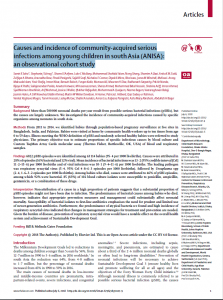
More than 500 000 neonatal deaths per year result from possible serious bacterial infections (pSBIs), but the causes are largely unknown. We investigated the incidence of community-acquired infections caused by specific organisms among neonates in south Asia.
From 2011 to 2014, we identified babies through population-based pregnancy surveillance at five sites in Bangladesh, India, and Pakistan. Babies were visited at home by community health workers up to ten times from age 0 to 59 days. Illness meeting the WHO definition of pSBI and randomly selected healthy babies were referred to study physicians. The primary objective was to estimate proportions of specific infectious causes by blood culture and Custom TaqMan Array Cards molecular assay (Thermo Fisher, Bartlesville, OK, USA) of blood and respiratory samples.
6022 pSBI episodes were identified among 63 114 babies (95·4 per 1000 livebirths). Causes were attributed in 28% of episodes (16% bacterial and 12% viral). Mean incidence of bacterial infections was 13·2 (95% credible interval [CrI] 11·2–15·6) per 1000 livebirths and of viral infections was 10·1 (9·4–11·6) per 1000 livebirths. The leading pathogen was respiratory syncytial virus (5·4, 95% CrI 4·8–6·3 episodes per 1000 livebirths), followed by Ureaplasma spp (2·4, 1·6–3·2 episodes per 1000 livebirths). Among babies who died, causes were attributed to 46% of pSBI episodes, among which 92% were bacterial. 85 (83%) of 102 blood culture isolates were susceptible to penicillin, ampicillin, gentamicin, or a combination of these drugs.
Non-attribution of a cause in a high proportion of patients suggests that a substantial proportion of pSBI episodes might not have been due to infection. The predominance of bacterial causes among babies who died, however, indicates that appropriate prevention measures and management could substantially affect neonatal mortality. Susceptibility of bacterial isolates to first-line antibiotics emphasises the need for prudent and limited use of newer-generation antibiotics. Furthermore, the predominance of atypical bacteria we found and high incidence of respiratory syncytial virus indicated that changes in management strategies for treatment and prevention are needed. Given the burden of disease, prevention of respiratory syncytial virus would have a notable effect on the overall health system and achievement of Sustainable Development Goal.
This paper was awarded the prestigious CDC Charles C. Shepard Science award. Established in 1986, the CDC/ATSDR Charles C. Shepard Science Award was named in honor of Dr. Charles C. Shepard, M.D., the internationally recognized microbiologist who was chief of the Leprosy and Rickettsia Branch at CDC for more than 30 years, until his death on February 18, 1985. The Charles C. Shepard Science Award can be awarded both for scientific publications and for lifetime scientific achievement. For scientific publications, the award is presented to the best manuscript on original research published by a CDC or ATSDR scientist in a reputable, peer-reviewed journal. For lifetime scientific achievement, the award is given to an individual with a body of scientific work contributing to public health. In some years, the award may not be given in all categories.
Please find the related commentary “Improving management of neonatal infections” in The Lancet here.